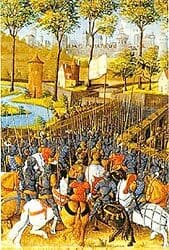
Crusaders attacking Damascus
Neil Faulkner Archive | ETOL Main Page
From Socialist Worker, Issue 2101, 13 May 2008.
Downloaded with thanks from the Socialist Worker Website.
Marked up by Einde O’Callaghan for the Encyclopaedia of Trotskyism On-Line (ETOL).
Neil Faulkner continues our series with warfare’s development from feudalism onwards

Crusaders attacking Damascus |
When Alexander the Great’s army captured Persepolis, the capital of the Persian Empire, in 331 BC, the treasure seized was equivalent to 300 times the annual income of the richest city in Greece.
In antiquity, war was profitable. It was the easiest way for ruling classes to get rich.
The ancient world was divided into rival states. Each state was, in essence, an army controlled by the ruler. The most belligerent rulers used their armies to conquer other states and create empires.
That forced the less belligerent to divert resources into fortifications and armies to avoid being taken over.
Farming was the basis of the economy. The rulers accumulated wealth by levying tribute on the peasants who worked the land.
Some of this wealth was wasted on palaces, temples, and luxuries, but a lot of it was spent on armies.
Armies had a double role. They could be used to crush protest from below and force the exploited to continue to pay the tax and rent that supported the state and the landlords.
And they could also be used in foreign wars, either in defence of existing territory or in aggressive campaigns to conquer more.
Philip II, father of Alexander the Great, turned the kingdom of Macedonia into a mini-empire by conquering much of the Balkans. This made him the richest and most powerful ruler in the region.
He could then afford a large professional army with which to subjugate the rest of the Greeks. This gave the Macedonians their launchpad for the conquest of the Persian Empire.
The Romans were even more successful. During 500 years of expansion, the Roman Empire was at peace for just two years.
War was normal. The Roman state waged wars of plunder, enslavement, and annexation.
Victory brought in wealth to enrich the ruling class, build monuments, enlarge the army and reward key client-groups like the citizen-soldiers who formed the legions.
Each successful campaign created the means to launch the next. Rome became a global mechanism of robbery with violence.
The medieval world worked in a similar way. It was divided into rival states, and each was dominated by a warrior ruling class. This was especially true of European feudalism.
Land and labour were divided into separate units, known as “fiefs”. Each was able to support a warrior-knight.
So feudal warlords competed for the land and labour needed to enlarge their armed retinues.
One horrific result was the Crusades. The violence inherent in feudalism was exported to the Middle East.
The Crusaders first massacred and plundered, then carved out new principalities and fiefdoms, squeezing the Arab peasantry to pay for castles, horses, armour and luxuries.
By the 16th century, war was changing as a new capitalist system developed. War acquired a new dimension.
The world was still divided into rival states, and wars were still fought for plunder, land, and empire. But now profit became a motive.
Plunder is taken from existing wealth, whereas profit comes from newly-created wealth.
The wars of early capitalism were wars between states, representing different groups of capitalists, for control of the trade routes, raw materials and new markets from which profits could be made.
With industrialisation, new weapons were developed – such as muskets and cannon.
Local resistance to imperialism – to slave raids, colonies, plantations, forced labour and other kinds of exploitation – was blasted away by gunpowder and shot.
At the same time, the great powers fought each other in a series of massive wars centred on Europe between 1618 and 1815.
The traditional rivalries between states, new rivalries over trade and colonies and gunpowder weapons combined to make these big and bloody.
The new technologies of killing would culminate in rifles, machine guns, and modern artillery.
In a single morning at Omdurman in 1898, British soldiers killed 11,000 Sudanese fighters for a loss of less than 50 men.
In the first month’s fighting of the First World War the French army suffered 300,000 casualties.
The world wars of modern capitalism were infernos of slaughter, destruction and waste without parallel in human history.
But because of this, they would unleash an unprecedented wave of revolution and anti-war protest with the potential to end war forever.
Neil Faulkner Archive | ETOL Main Page
Last updated on: 10 February 2022